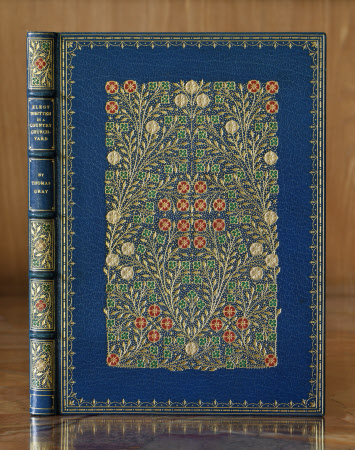Elegy written in a country churchyard / Thomas Gray.
Thomas Gray (1716-1771)
Category
Books
Date
1932
Materials
Place of origin
London
Order this imageCollection
Anglesey Abbey, Cambridgeshire
NT 3151331
Summary
Thomas Gray, Elegy written in a Country Churchyard [Calligraphic manuscript on vellum, written and illuminated by Alberto Sangorski, c. 1925] Binding: Blue goatskin, with white, red and green goattskin onlays, elaborately gilt-tooled. Watered-silk endleaves, with gilt tooled goatskin turn-ins. The lower board is decorated to a simpler pattern.
Full description
Bookbinding, like all other aspects of the book trade, was transformed during the nineteenth century through mechanisation and the introduction of new techniques. What used to be a handcrafted process, carried out in small workshops, came to be undertaken on a more industrial scale, with prefabricated cloth binding cases made in great quantities for ever-growing edition sizes. These new types of binding developed a lively decorative culture of their own, with some striking designs made for blocking onto binders’ cloth, while the traditional skills in tooling leather-covered bindings suffered something of a decline, continuing to be carried out, but without much flair. The man who is widely acknowledged as having regenerated bookbinding in Britain at the end of the nineteenth century, and set in train the modern rediscovery of binding as an art form, is Thomas Cobden-Sanderson (1840-1922). After some rather unhappy years spent as a lawyer, he was inspired by William Morris's wife, Jane, to take up bookbinding, and after training with a professional firm in 1884 he began working independently. The bindings he produced himself, or which were made to his designs at the Doves bindery which he founded, have been admired and collected ever since. Exquisitely crafted, they typically incorporate intricate but delicate patterns, inspired by roses or similar foliage, covering the boards with intertwining stems reminiscent of a summer garden in full bloom. Lord Fairhaven did not own any bindings by Cobden-Sanderson, but many of his fine modern bindings grew out of the tradition thus re-established for beautifully produced, handmade, leather bindings. The example here is the one from Anglesey's shelves which is perhaps most reminiscent of a Cobden-Sanderson design; its intense floral pattern, achieved by the meticulous placing of small gilt tools and multi-coloured leather onlays, is simple, naturalistic and spectacular. It was made by the firm of Sangorski & Sutcliffe, one of the leading London West End binderies of the early twentieth century. The binding here is very much a family production, as it covers a manuscript copy of Gray's Elegy written and illuminated by Francis Sangorski's elder brother Alberto (1862-1932), who specialised in this kind of high-end calligraphy. Lord Fairhaven paid the very considerable sum of £150 for this book. Text adapted from David Pearson's entry in 'Treasures from Lord Fairhaven's Library at Anglesey Abbey', 2013, cat. 47, pp. 144-5.
Bibliographic description
21, [1] p. : col. ill., ports. ; 8vo. Provenance: Twentieth-century armorial bookplate (small variant), signed Badeley 1930: ‘Urban Huttleston Rogers Lord Fairhaven’ [i.e.: Urban Huttleston Rogers Broughton, 1st Lord Fairhaven (1896-1966)]. Loosely inserted: typed description of book by dealer Charles J. Sawyer, with price £150. Binding: Twentieth-century full blue morocco binding over boards; gilt fillets and tools to form a border; elaborate gilt floral centrepiece on upper board, inlaid with flowers in green and red; gilt tools and red inlaid floral cornerpieces to form a central panel on lower board; gilt-panelled spine with red and brown inlaid flowers; sewn on five raised bands; gilt spine title ‘Elegy written in a country church-yard. By Thomas Gray’; gilt fillets on board edges; gilt textblock edges; gilt fillets and tools to form inner border; cream watered silk endpapers. In brown morocco box, with gilt spine title and gilt stamp of Lord Fairhaven's crest at head of spine. Binding is by Sangorski & Sutcliffe: identified as such by typed letters between Stanley Bray of Sangorski & Sutcliffe, Paul Woudhuysen of the Fitzwilliam Museum, Cambridge, and the bookdealer Charles Sawyer, all dated November 1977, loosely inserted in box.
Provenance
Acquired by Huttleston Rogers Broughton, 1st Lord Fairhaven (1896-1966) and then bequeathed by him to the National Trust with the house and the rest of the contents in 1966.
Makers and roles
Thomas Gray (1716-1771), author Alberto Sangorski (1862-1932), illuminator
References
Mark Purcell, William Hale and David Person, Treasures from Lord Fairhaven’s Library at Anglesey Abbey, Swindon: National Trust; London: Scala Arts & Heritage Publishers, 2013., pp. 144-145
